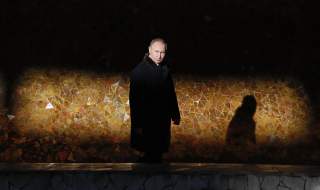From Mutually Assured Destruction to Mutually Assured Delusion (and Back?)
While separatist insurgency lingers in Russia’s North Caucasus, it is a far cry from the 1990s and early 2000s.
2. America is collapsing.
According to a 2009 prediction by Igor Panarin, a professor of the Russian Foreign Ministry’s Diplomatic Academy and former press secretary of the country’s space agency, the United States was to disintegrate in 2010 due to a “moral-psychological crisis,” “social tensions,” economic and financial woes and finally “legal disintegration” pushed for by individual American states. In reality, while America may be becoming increasingly polarized, there are no signs that it is breaking apart along any kind of moral or social lines. Its economic performance is also far from being abysmal. Western countries’ share in the world’s GDP may be shrinking, but America’s economy still remains nearly five times the size of Russia’s, and its share of global GDP was 15.4 percent in 2017 (PPP) versus Russia’s 3.2 percent. In other measures of national strength, America’s share in global defense expenditures amounted to 36.1 percent in 2016 compared to Russia’s 4.2 percent, and demographically America has been growing more rapidly than Russia in the twenty-first century, with a population more than double the size of Russia’s. If Putin were, indeed, to overestimate America’s weaknesses, he would be more tempted to act more assertively against America (just like American leaders would if they viewed Russia as a declining power). Such assertiveness would then invite a U.S. response that could escalate tensions between the two countries, again increasing chances of a conflict between them.
Conclusion
Mutual misapprehensions were common during the Cold War when the Soviet Union represented what Churchill described as a “riddle, wrapped in a mystery, inside an enigma.” Some of them were relatively harmless, such as Ronald Reagan’s belief that there is no Russian word for freedom. Others could have led to a nuclear Armageddon, such as the Soviet leadership’s false belief that NATO’s 1983 Able Archer exercise could have been preparation for a first nuclear strike. These misapprehensions waned after the end of the Cold War as contacts between the United States and post-Soviet Russia flourished on all levels, including contacts among members of both countries’ expert communities. However, the mutually assured delusion reared its ahead again as the relations between the United States and Russia soured once more in the wake of the Ukraine crisis. These misapprehensions may result from a lack of country expertise—which has been widely acknowledged in America, but is no less acute in Russia—or they may stem from wishful thinking. It is, of course, easier to seek confirmation of one’s misbeliefs in the opinions like-minded fellows than to acquaint oneself with the full range of views held by experts on the issue. Moreover, some U.S. policymakers and influencers seeking confirmation of their views on trends in Russia may find such reassurance in Moscow itself, and vice versa for the Russian policy crowd. For instance, those who claim to see twenty-first century Russia declining from their offices in Washington may be reassured that some Russian experts view the country not just as declining, but in some kind of agony. Likewise, former Russian space spokesman Panarin—who believes America is collapsing—can, perhaps, feel reassured in his outlandish views by an American anthropologist’s book arguing that America is approaching a period of disintegration.
Should these mutually reinforced misapprehensions continue to spread wide and high in policy-making circles, they can eventually increase the chances of the two countries stumbling into a war, in my view. If U.S. and Russian decision-makers do not just profess but also genuinely believe in the continuing decline and pending collapse of each other’s countries, then chances are they will act more assertively against each other. If Russia’s ultimate decision-maker Vladimir Putin were to believe that America is, indeed, hungrily plotting to first take away Siberia’s riches from Russia and then dismember his country altogether, then he is bound to misinterpret the United States and its allies’ true intentions, just as the Soviet leadership did during NATO’s Able Archer exercise in 1983, and to overreact to American actions in ways that would fuel confrontation between the two countries, increasing the chance of an armed conflict. As an adage attributed to Mark Twain goes: “It ain’t what you don’t know that gets you into trouble. It’s what you know for sure that just ain’t so.” It is, therefore, important for policymakers to base their views and actions on established facts about the past and present. As for the future, one would do well to acquaint oneself with the entire range of scenarios outlined by those with proven expertise rather than engage in wishful thinking about the rival country’s imminent collapse. It is imperative for leaders on both sides to get the facts straight, if only to prevent any mutually assured delusions from edging their countries closer to mutually assured destruction.
Simon Saradzhyan is the founding director of the Russia Matters Project at Harvard Kennedy School’s Belfer Center for Science and International Affairs. Mr. Saradzhyan also helps advance the center’s U.S.-Russia Initiative to Prevent Nuclear Terrorism. His research interests include international arms control, counterterrorism, and foreign, defense, and security policies of Russia and other post-Soviet states and their relations with great powers.
Image: Russian President Vladimir Putin attends a wreath laying ceremony during an event to commemorate the 75th anniversary of the battle of Stalingrad in World War Two, at the Mamayev Kurgan memorial complex in the city of Volgograd, Russia February 2, 2018. Sputnik/Alexei Druzhinin/Kremlin via REUTERS

